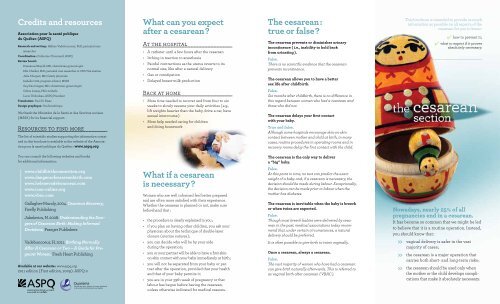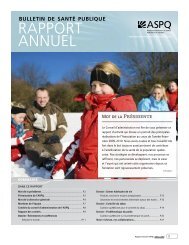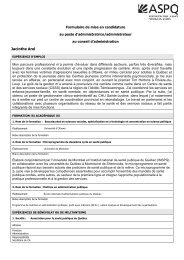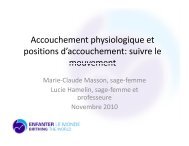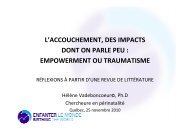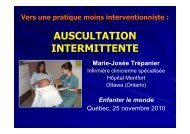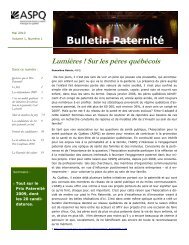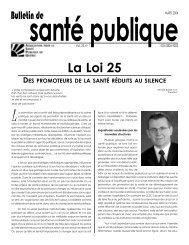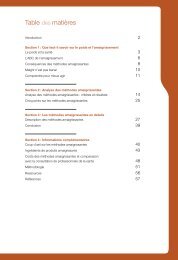The cesarean - Association pour la santé publique du Québec
The cesarean - Association pour la santé publique du Québec
The cesarean - Association pour la santé publique du Québec
You also want an ePaper? Increase the reach of your titles
YUMPU automatically turns print PDFs into web optimized ePapers that Google loves.
Credits and resources<strong>Association</strong> <strong>pour</strong> <strong>la</strong> santé <strong>publique</strong><strong>du</strong> Québec (ASPQ)Research and writing : Hélène Vadeboncoeur, PhD, perinatal careresearcherCoordination : Catherine Chouinard, ASPQReview board :Emmanuel Bujold, MD, obstetrician-gynecologistNils Chaillet, PhD, perinatal care researcher at CHU Ste-JustineJulie Choquet, MD, family physicianIsabelle Côté, program advisor, MSSSGuy-Paul Gagné, MD, obstetrician-gynecologistCéline Lemay, PhD, midwifeLucie Thibodeau, ASPQ PresidentTrans<strong>la</strong>tion : Paul Di BiaseDesign graphique : StudiométriqueWe thank the Ministère de <strong>la</strong> Santé et des Services sociaux( MSSS ) for its financial support.Resources to find more<strong>The</strong> list of scientific studies supporting the information containedin this brochure is avai<strong>la</strong>ble at the website of the <strong>Association</strong><strong>pour</strong> <strong>la</strong> santé <strong>publique</strong> <strong>du</strong> Québec : www.aspq.orgWhat can you expectafter a <strong>cesarean</strong> ?At the hospital• A catheter until a few hours after the <strong>cesarean</strong>• Itching in reaction to anesthesia• Painful contractions as the uterus reverts to itsnormal size, like after a natural delivery• Gas or constipation• De<strong>la</strong>yed breast-milk pro<strong>du</strong>ctionBack at home• More time needed to recover and from four to sixweeks to slowly resume your daily activities ( e.g.,lift weights heavier than the baby, drive a car, havesexual intercourse )• More help needed caring for childrenand doing housework<strong>The</strong> <strong>cesarean</strong> :true or false ?<strong>The</strong> <strong>cesarean</strong> prevents or diminishes urinaryincontinence ( i.e., inability to hold backfrom urinating ).False.<strong>The</strong>re is no scientific evidence that the <strong>cesarean</strong>prevents incontinence.<strong>The</strong> <strong>cesarean</strong> allows you to have a bettersex life after childbirth.False..Six months after childbirth, there is no difference inthis regard between women who had a <strong>cesarean</strong> andthose who did not.<strong>The</strong> <strong>cesarean</strong> de<strong>la</strong>ys your first contactwith your baby.True and false.Although some hospitals encourage skin-on-skincontact between mother and child at birth, in manycases, routine proce<strong>du</strong>res in operating rooms and inrecovery rooms de<strong>la</strong>y the first contact with the child.This brochure is intended to provide as muchinformation as possible on all aspects of the<strong>cesarean</strong> for you to know :how to prevent it ;what to expect if it provesabsolutely necessary.You can consult the following websites and booksfor additional information :<strong>The</strong> <strong>cesarean</strong> is the only way to delivera “big” baby.False.At this point in time, no test can predict the exactweight of a baby and, if a <strong>cesarean</strong> is necessary, thedecision should be made <strong>du</strong>ring <strong>la</strong>bour. Exceptionally,the decision can be made prior to <strong>la</strong>bour when themother has diabetes.www.childbirthconnection.orgwww.dangersof<strong>cesarean</strong>birth.comwww.helenevadeboncoeur.comwww.ican-online.orgwww.vbac.comGal<strong>la</strong>gher-Mundy, 2004. Cesarean Recovery,Firefly PublishingJukelevics, N. 2008. Understanding the Dangersof Cesarean Birth: Making InformedDecisions, Praeger PublishersVadeboncoeur, H. 2011. Birthing NormallyAfter A Cesarean or Two – A Guide for PregnantWomen, Fresh Heart PublishingAvai<strong>la</strong>ble at our website : www.aspq.org2011 edition ( First edition, 2009 ). ASPQ ©What if a <strong>cesarean</strong>is necessary ?Women who are well informed feel better preparedand are often more satisfied with their experience.Whether the <strong>cesarean</strong> is p<strong>la</strong>nned or not, make surebeforehand that :• the proce<strong>du</strong>re is clearly exp<strong>la</strong>ined to you ;• if you p<strong>la</strong>n on having other children, you ask yourphysician about the technique of double-<strong>la</strong>yerclosure ( uterine sutures ) ;• you can decide who will be by your side<strong>du</strong>ring the operation ;• you or your partner will be able to have a first skinon-skincontact with your baby immediately at birth ;• you will not be separated from your baby or partnerafter the operation, provided that your healthand that of your baby permits it ;• you are in your 39th week of pregnancy or that<strong>la</strong>bour has begun before having the <strong>cesarean</strong>,unless otherwise indicated for medical reasons.<strong>The</strong> <strong>cesarean</strong> is inevitable when the baby is breechor when twins are expected.False.Though most breech babies were delivered by <strong>cesarean</strong>in the past, medical associations today recommendthat, under certain circumstances, a naturaldelivery should be preferred.It is often possible to give birth to twins vaginally.Once a <strong>cesarean</strong>, always a <strong>cesarean</strong>.False.<strong>The</strong> vast majority of women who have had a <strong>cesarean</strong>can give birth naturally afterwards. This is referred toas vaginal birth after <strong>cesarean</strong> ( VBAC ).Nowadays, nearly 25% of allpregnancies end in a <strong>cesarean</strong>.It has become so common that we might be ledto believe that it is a routine operation. Instead,you should know that :»»»vaginal delivery is safer in the vastmajority of cases ;the <strong>cesarean</strong> is a major operation thatcarries both short- and long-term risks ;the <strong>cesarean</strong> should be used only whenthe mother or the child develops complicationsthat make it absolutely necessary.
What is a <strong>cesarean</strong> ?It is an incision made in the mother’s belly in orderto extract the baby from her uterus. <strong>The</strong> <strong>cesarean</strong>is generally practised under an epi<strong>du</strong>ral or spina<strong>la</strong>nesthetic. It rarely requires general anesthesia. <strong>The</strong>entire operation <strong>la</strong>sts about one hour.<strong>The</strong> <strong>cesarean</strong> entails :• preparation: catheter, IV drip, shaving of pubichair, and anesthesia ;• a sterile environment: operating room, gloves,mask, scrubs, etc., for the partner as well ;• an incision in the skin, which will <strong>la</strong>ter be closedwith dissolving sutures or non-dissolving staple ;• possibly feeling pressure, pulling and nausea ;• a period of time in a recovery room for the mothereven if she was not p<strong>la</strong>ced under general anesthesia ;• a longer hospital stay and a longer recovery.Why practisea <strong>cesarean</strong> ?In Quebec, 90% of <strong>cesarean</strong>s are practisedfor the following reasons :• <strong>la</strong>bour has stalled or is very slow ;• the mother has had a previous <strong>cesarean</strong> ;• the baby is breech ;• the baby’s condition iscause for concern.However, in each of these cases, the<strong>cesarean</strong> is not the only option.In some cases, the <strong>cesarean</strong> is essentia<strong>la</strong>nd even urgent, for example:• if the p<strong>la</strong>centa blocks the baby’s wayout of the womb ( p<strong>la</strong>centa previa ) ;présentation par le siègeet p<strong>la</strong>centa praevia.• if the umbilical chord descends beforethe baby’s head does ( pro<strong>la</strong>psed umbilical chord ).Are there risksassociated witha <strong>cesarean</strong> ?Fortunately most <strong>cesarean</strong>s pose no problem. However,as with any major surgical proce<strong>du</strong>re, it carriesrisks. <strong>The</strong>se risks can be high or low, dependingon the case, for both the mother and the baby. Forexample :For the motherShort term :• problems breastfeeding• injury ( lesions ) to organs near the uterus,such as the b<strong>la</strong>dder• serious complications ( rare ): death, infection,cardiac arrest, hysterectomy, haemorrhage orembolism• admission to intensive care• rehospitalizationLong term :• adhesions (persistent pain at the scar siteand <strong>du</strong>ring sexual intercourse, seriousintestinal problems)• fertility problemsFor the babyShort term :• injury from a surgical instrument• sometimes serious respiratory problems, especiallyif the <strong>cesarean</strong> is practised before the 39thweek of pregnancyLong term :• AsthmaFuture pregnanciesFor the mother :• extra-uterine pregnancy• serious p<strong>la</strong>centa-re<strong>la</strong>ted complications• uterine rupture ( scar on uterus tears open )• admission to intensive care• hysterectomyFor the baby :• underweight at birth• perinatal deathWhat are the potentialeffects of a <strong>cesarean</strong> ?»• Some women feel relieved after having a <strong>cesarean</strong>.For others, the <strong>cesarean</strong> represents an ordeal. <strong>The</strong>ycan experience difficult emotions, such as distress,disappointment, a sense of abandonment, anger,betrayal, loss of control, and even a sense of failure,because they were “unable to give birth naturally”.• In some cases, the <strong>cesarean</strong> can de<strong>la</strong>y the firstcontact between a mother and her baby, which attimes can have an impact on the first moments ofbreastfeeding and how successful it will be.If following a <strong>cesarean</strong> you havedifficulty resuming your activitiesor caring for your baby because theemotions you feel are overwhelming,do not hesitate to consult ahealthcare professional.Can a <strong>cesarean</strong>be prevented ?Here re a few tips to re<strong>du</strong>ce the riskof needing a <strong>cesarean</strong> :During pregnancy…• prepare for delivery ( stay fit, attend prenatalcourses, draw up a birth p<strong>la</strong>n )• see a healthcare professional ( midwife, familyphysician or obstetrician-gynecologist ) on aregu<strong>la</strong>r basis• have a dou<strong>la</strong> by your side <strong>du</strong>ring delivery• if the baby is breech, request that an externalcephalic version be attempted in a hospital• if a <strong>cesarean</strong> is recommended, ask whyand find out about your possible options• wait until your contractions are regu<strong>la</strong>r and fiveminutes apart or to have lost amniotic fluidbefore heading out to where you will give birthDuring <strong>la</strong>bour…• keep moving ( walk, change position often )• take a bath• eat and drink as needed• when pushing, a vertical position is preferable( stand, sit or squat )• as much as possible, it is best to avoid :»»in<strong>du</strong>cing <strong>la</strong>bour artificially»»continuous monitoring of the fetus ( baby’sheartbeat ), which forces the mother to staylying in bed»»rupturing the amniotic sac artificially»»epi<strong>du</strong>ral anesthesia before being di<strong>la</strong>ted 4 cm»»setting a deadline to deliver»»being on your back to give birth


